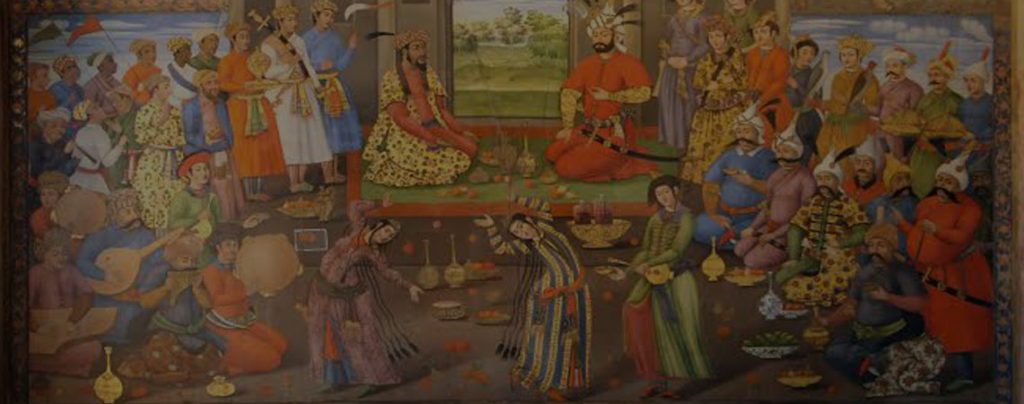

Sonakshi Srivastava
Sonakshi Srivastava is a final year post graduate student of English Literature at Delhi University, and has an array of interests, ranging from creative writing to academia. A culture and arts enthusiast, she is currently intrigued by memes, and hopes to fulfil her mission of conquering world literature when not engaged with memes.
The Curious Case of Awadhi Dastarkhwan
Cafarvy wrote of Alexandria, ‘the city will always haunt you’, a sentiment that can be well applied to Lucknow, ‘the city of Nawabs’.
Historically, Lucknow bears a strong allegiance to the Mughal culture – cradled in the Awadh region which was one of the 12 subas of the Mughal emperor, Akbar. Awadh/Oudh derives its name from Ayodhya, and ‘Nawab’- the plural of the word ‘naib’ meaning assistant, was the term given to governors appointed by the Mughal emperors all over India to ease them in managing the empire.
“Lucknow’s culturally evolved lifestyle and exotic cuisines owe their genesis to a heady mix of idiosyncratic nawabs, powerful begums, eccentric chefs, clever ministers and ‘rang-mizazi’ subjects.”
Awadhi cuisine is a hybrid of culinary practices across the Mughal Durbar (itself a mix of the Turkish, Central Asian food cultures) (references and even recipes of biryani-s and other gastronomic delights can be found in Abul Fazl’s accounts), the Safavid Court in Iran, where the first Nawab, Sadat Khan emigrated from, and the European influences, especially the French and Portuguese, truly rendering it a melting pot.
The Awadhi Dastarkhwan (Persian term) is the customary Awadhi dining spread, and includes:
- Korma (main gravy dish)
- Salan (thin sauce, peppered with spices and small round balls or ‘koftas’ – cousin to the ‘shubh degh’ from Kashmir)
- Kebab
- Pasinda
- Rice (biryani, pulao)
- Rotis (sheermal, nahari kulchas, roomali rotis)
- Meetha (shahi tukda, halwa, phirni)
“The 19th century painting of an uneasy Nawab Ghazi-ud-Din Haidar, the last Nawab of Lucknow dining with Lord and Lady Moira bears a nostalgic allusion to the absence of the grand Dastarkhwan in favour of a more ‘appropriate’, and ‘prim and proper’ English culinary fare”
A very pavlovian conjecture of Awadhi cuisines brings to one’s mind the Kebabs, and the Biryani. For a tradition so rich, these epicurean delights amongst others are also bearers of the luxuriantly decadent lifestyles of the nawabs, and have certain anecdotes that are still exchanged over the dining table in Lakhnavi households.
That the Nawabs embraced life voluptuously is largely incontestable, and certain popular anecdotes ascertain the statement. The last Nawab, Ghazi-ud-Din was particularly fond of parathas, so much so that his bawarchi (cook) prepared 6 parathas by consuming 30 seers of ghee per day. The prime minister, Agha Mir expressed displeasure at the over generous use of ghee and slashed it down to just 6 seers per day on the pretext of saving the resources of the estate. When Ghazi-ud-Din was served the qualitatively deteriorated parathas, he was enraged and is said to have slapped Agha Mir – for in providing the Nawab with poor food, was he not ‘robbing the estate’!? Agha Mir had to apologize incessantly, and learnt the lesson of never disrupting the Nawab’s way with his food.
Another popular gastronomic reminiscence is of a bawarchi (cook) who grew so upset with the unnecessary meddling of an old Nawab with his way of cooking that he emptied an entire bowl of his ‘urad dal’ at the base of a dead tree, and which after a certain time had shown signs of life!
Records abound of bawarchis and rakabdars (gourmet chefs) feeding animals with zafran (saffron) pills to infuse their flesh, contributing to some real ambrosial servings.These yarns bear testimony to the grand history of Awadhi cuisine that has yet not betrayed a connoisseur’s palate.:
The savoury ‘tunde kebabs’ have an interesting inception. When bawarchi Haji Murad Ali fell off the roof of his house, he lost an arm. Yet, he continued perfecting the mixture of shahi galawat, working expertly with one hand, so much so that the shahi galawat came to be known as tunde kebabs, and have become an indelible identity of Lucknow.
It is worth mentioning that the kebabs of Lucknow are particularly delicate and soft owing to the bad teeth (no guesses why!) of Nawab Asaf-ud-Daula, who also considered chewing primitive. So much so for the ‘nazakat’ and ‘tehzeeb’ of fine dining in Awadh.
Awadhi Biryani differs from its parent, Mughlai Biryani in tones of spiciness. Also called ‘Pukki Biryani’, it is cooked in ‘pukki’ style. Food historians are divided over the origins of Biryani, some claiming that it travelled via Iran, Afghanistan, and Peshawar to Delhi, while some attributes its origin to Central Asia. The ‘Calcutta Biryani’ is an offspring of Awadhi Biryani – a modified version birthed by the bawarchis and khansamas of the exiled Nawab Wajid Ali Shah in Calcutta. Paucity of resources could not possibly hinder the gastronomical urges of the Nawab. His kitchen staff innovatively toned down on the spices, and substituted potatoes for meat. Although some records mention that potatoes at that time were exotic in themselves, but whatever the case, the Nawab had had his way. If anything, the shayari of Bismil can so well sum up the savoury effect of Awadhi biryani, ‘kiya tabah toh dilli ne bhi bahut ‘bismil’, magar khuda ki qasam lucknow ne luut liya’.
The ‘pukki’ style of cooking, or the ‘dum style’, the ‘dum pukht’ is peculiar to Lucknow – the art of cooking over slow fire which allows flavours to navigate through the minute crevices amongst rice grains, and spices to flow allowing the cuisine to obtain a silky texture.
The dum pukht style of cooking traces its origins to Arabic ‘mandi’ practice as well as the ‘gil-i-hikmutt’, the Persian practice of cooking where the earth is used as a natural seal. The latter is still prevalent amongst the hakims and vaidyas in Varanasi. Another interesting anecdote as to how the dum pukht style gained currency as a cooking technique goes like this: when the famine of 1784 hit Lucknow, Nawab Asaf-ud-Daula ordered the construction of the Bara Imambara as a part of the famine relief programme. The Nawab, a magnanimous ruler ordered food to be cooked in large pots (deghs) which were sealed, and charcoal was placed on the top while slow cooking ensured that the food was available day and night. When unsealed, the pots gave off an aromatic smell, and dum pukht can be deconstructed to cater to the gastrocritical mind as ‘dum’ meaning ‘breathe in’ and ‘pukht’ meaning ‘to cook.’ The local epigram ‘Jisko na de Maulla, usko de Asaf-ud-Daula’ (He who does not receive from God, will receive from Asaf-ud-Daula) can also be humorously understood as an additional contribution to the culinary delights of Lucknow.

Other cooking techniques peculiar to Lucknow include:
- Baghar – tempering a dish with hot oil/ghee and spices
- Dhungar- using quick smoke
- Galawat – using softening agents, like raw papaya
- Loab- the final stage of cooking, where the oil simmers and rises to the surface.
- Using ‘moin’ (yeast), ‘itr’ (perfume), ‘chandi warq’, ‘Yakhni’ cuts
Certain food historians also credit the origin of the popular Scottish Eggs to Lucknow, an off spring of the Awadhi dish, Nargisi Kofta which consists of eggs covered in minced lamb and cooked in curried tomatoes. Another popular dish that probably owes its origins to Lucknow is the Tandoori Chicken. It is believed that to keep the Nawab intrigued with their skills, a bawarchi tried hiding chicken in tandoors (bell shaped clay ovens) used mostly to prepare naans. The final dish turned out to be Tandoori Chicken, which was succulent inside and crispy outside.
The royal kitchen was particularly influenced by the French technique of ‘multiple straining’, and also the Yunani technique of using rose water instead of plain water as a remedial liquid to ameliorate probable digestive discomforts. ‘Potli Masala’, a mixture of 120 spices (not store bought) and rejuvenating herbs is the most commonly used mixture of spices and herbs till date, passed down from centuries that is still employed in creating the signature Awadhi cuisine.
Awadhi Pulao is as popular as its cousin, Awadhi Biryani. Certain varieties of pulaos which satisfy not only the palate but also the creative fancies of its connoisseurs –‘gulzar’ (garden), ‘nur’ (light), ‘koku’ (cuckoo), ‘moti’ (pearl), ‘chameli’(jasmine). Awadhi culture influenced the gastronomics of Kapurthala as well, and mention can be made of certain mango and orange pulaos which were Wajid Ali Shah’s favourite.
The ‘Murgh Musullum’ (where a whole chicken is wrapped in muslin, dressed with spices and ghee and baked in a low sealed vessel sealed with a rope of dough), the ‘sheermal’ (saffron covered parathas), the ‘taftan’ (fermented, sweet bread), ‘zarda’ (sweetened rice generously peppered with dry fruits), and the melt in the mouth ‘paans’ and ‘malai makhan’ are some of the most authentic delights that Lucknow dishes up.
The pleasure – friendly Nawabs sought ways to be entertained – and their bawarchis and rakabdars catered to their patrons’ sensory delights by literally and figuratively ‘cooking up’ – and one such ‘cooked up’ project was deceiving the diner. Records enumerate instances where an old Nawab was sent a single puffed up puri as a ceremonial dish. Dismayed by the quantity, he punctured the puri with his fingers, and surprise- a dove flew out of it. This was the parind (bird) puri. Another incident includes rice grains dyed and arranged in such a manner so as to give the semblance of navrattan pulao, while yet another account recounts the story of Wajid Ali Shah inviting Prince Mirza Asman Qadar, a connoisseur from Dilli to dine with him and finally tricking him into eating ‘murabba’ which actually turned out to be ‘korma’!
Any mention of Awadhi cuisine is incomplete without a sweet, sweet reference to the mangoes which again go by such poetic names as gulab-khas, husnara, lab-e-mashuk, khas-ul-khas, tota pari, et al. Malihabad is the ideal place to savour the mangoes, while the Dussehri variety is the most popular. Every summer, mango fests are religiously organized in Lucknow that allow mango connoisseurs to exhibit their home-grown mango varieties or simply gorge on the plethora of mango varieties available.
If you happen to dislike mangoes, and at the same time happen to be in Lucknow – you will be greeted with the popular retort, ‘only a donkey doesn’t eat mangoes’, alluding to Ghalib, who was so fond of mangoes that he composed a masnavi, ‘Dar Sifat-e-Ambaah’ (On the Attributes of Mango), and who wittingly rebutted a friend by declaring that ‘only a donkey does not eat mangoes’.
‘mujhse poochho, tumheñ khabar kya hai
aam ke aage neyshakar kya hai…
ya ye hoga ke fart-e rafa’at se
baagh-baanoñ ne baagh-e jannat se
angabeeñ ke, ba hukm-e rabb-in-naas
bhar ke bheje haiñ sar-ba-mohr gilaas’
Awadhi cuisine doesn’t merely gratify the appetite; it is an emotion that lingers for too long in one’s mouth leaving one with the after taste of a decadently glorious past that refuses to ebb with age.




















